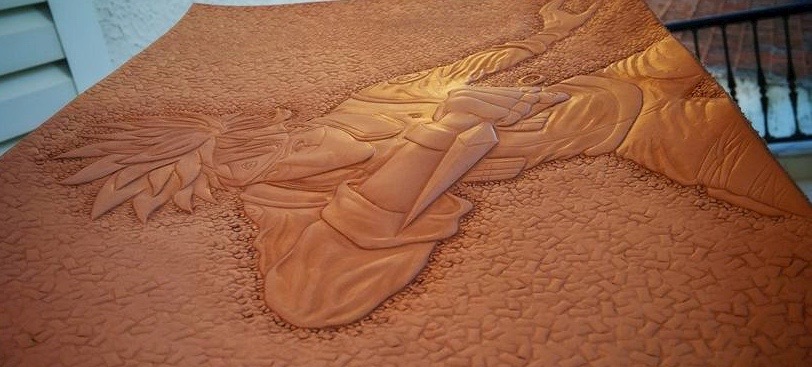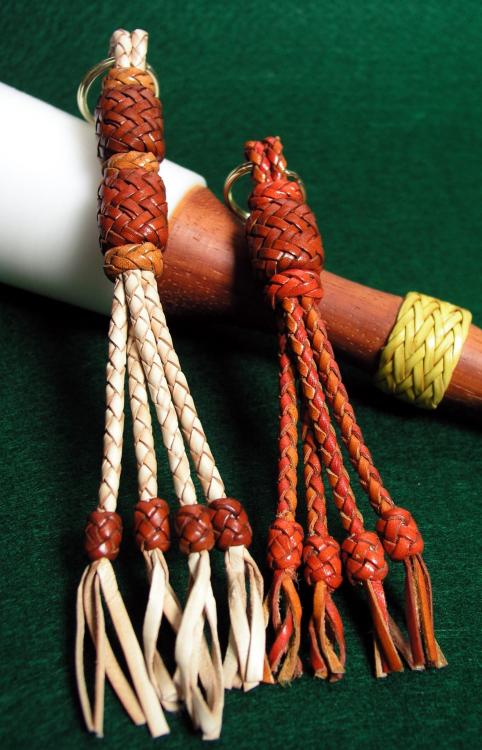-
Posts
2,372 -
Joined
-
Last visited
Content Type
Profiles
Forums
Events
Blogs
Gallery
Everything posted by immiketoo
-
We buy a mold spray here that I use. Its pretty strong, no idea of the percentage. I do wipe it down afterwards with fresh water.
-
If you've ever tried to resist dye with tan kote or supersheen or whatever, you probably had less than stellar results. Using liquid frisket can do the job but there's a few things you need to know.
- 24 replies
-
- youcantresistthis
- frisket
-
(and 1 more)
Tagged with:
-

Using dyes in your leatherwork
immiketoo replied to WilburLeather's topic in Leatherwork Conversation
Bad stitching is like a beautiful woman with awful teeth. -

Lets talk about WOW factor in leatherwork.
immiketoo replied to immiketoo's topic in Leatherwork Conversation
@bikermutt07, still waiting to hear from you! -
Could be a pressed belt by Ellis Barnes. He has a lot of plates that were originally carved by Al. Pic will help for sure.
-
We have that problem here in Rhodes in the winter. I spray bleach on my items. Doesn't affect colors or finishes and works better than anything else. However, I don't know about your leather so test in an inconspicuous area or on scrap to be sure.
-

Leather Braiding Online Class with Robert Black
immiketoo replied to immiketoo's topic in How Do I Do That?
Yes, and no. We are considering holding a destination leather retreat here with great teachers, food, drinks and as much beach and sight seeing as you can handle, but this class is online so only I'll be here in Rhodes.- 2 replies
-
- learnleather.com
- robertblack
- (and 3 more)
-
Yes, thats the stuff. Here, its called brushing lacquer. The sprays are probably acrylic but I'm not 100% certain of that.
-
Folks, I am proud to announce that I have partnered up with Robert Black of Marlinspike Knot Works for a two part series on how to braid leather. Robert is well known for his video series, and he built this class to allow beginners and veterans alike to learn something. Hope to see you there! Please register for Decorative Knotting With Robert Black on Tuesday, May 29, 2018 7:00 PM - 8:30 PM CDT at: https://attendee.gototraining.com/r/7672318861482345473Join us as renowned braider Robert Black of Marlinspike Knotworks shares his decades of experience and knowledge in part one of of a two part series about decorative knotting with leather. In the two part series, Robert will explain and demonstrate a set of decorative knots and braids using a step-by-step sequence that is easy to understand and follow. Robert will provide a complete list of the tools, supplies and materials needed to complete the projects discussed and he will elaborate on knot tying skills which will become important building blocks for use in many other fancy knotting projects. Robert will explore how these building blocks can be combined to produce a wide variety of exciting projects which will provide enjoyment for many years to come. Knotting History Knot Tying Terms Tools & Supplies Tightening Skills Finishing Technique Constrictor Knot Spanish Ring Knot 7 Lead 6 Bight Turk’s Head Herringbone Interweave Gaucho Interweave 4 Strand Braid 8 Strand Braid After registering you will receive a confirmation email containing information about joining the training.
- 2 replies
-
- learnleather.com
- robertblack
- (and 3 more)
-
That's a long time ago! Shading with white is difficult, but you did a convincing job. Good eye too.
-
Your ticket for matte finish is either matte brushing lacquer for wood work, or the spray finishes from 3M or other brands. You can find all of them at hardware or woodworking stores.
-
Hey Floyd, If you're like most of us, you started in your kitchen or basement or wherever you had space. Entire projects are built in one tiny space. Great for conserving living areas but potentially bad for leatherwork. For example, you finish tooling, and now its time to color. You clean up your tools (or push them off to the side most likely) an break out your dyes. You begin coloring your piece and all of a sudden you knock over a bottle of dye ALL over you finished piece. After the appropriate cuss words are spoken, you clean up your space, the floor as best you can and you try and save your piece. Then, you realize you can't save it so you start over. Whilst tooling, you begin to see little spots of color you spilled showing up all over. On your hands, on your leather, even on your face. How did THIS happen? Answer. Dyestuffs are insidious, vile beasts that must be kept caged and properly harnessed. The are a powdery substance suspended in water or alcohol that when dry can sit, invisible to the eye, on any surface, including tools. When moisture is added, they activate and stain whatever they come in contact with. That's their job. The problem is what they are in contact with. Off the leash, they lie dormant until you put a big red fingerprint on a piece that was supposed to be natural. Or black where it was supposed to be tan. You get the idea. So, the rule of separation is formed. NEVER shall dye touch my tooling surface again. NEVER shall dye touch my cutting surface again. Dye, being the asshole that it is shouldn't even know the rest of your shop exists until its time to place it directly on the piece you want. So now, I have a cutting table and tooling slab that don't ever get dyes placed on them. I have holders for my dye bottles so I don't knock them over, and the problem is solved. Dyes stay on the dye bench. Sequestered. Forever.
-
Or years of practice. I thought I was getting the hang of it until I watched Barry King do it.
-
Don't worry. We ALL started that way, and you will be amazed at how much you learn in a short time if you pay attention.
-
Ok, I may draw some ire here, but you do not need to stitch the open parts i.e. throat and toe of the holster. You CAN for aesthetic reasons, but it is not necessary to do so provided you understand how to use contact cement properly. To test this, I sent some of my holsters to my cop buddies and told them to destroy them if they can. Cops are notoriously hard on gear and none of them has delaminated. Even with intentional neglect and abuse. Now, if you are worried about it for any reason, thread is cheap and it just adds one more step to your build process, so why not. Its also nice aesthetically, so there's that. Don't want to start an argument, so if you believe 100% that you must, then thats fine for you. I do it both ways, and both work for me. And Katsass is legend.
-
Thanks how many people mark them, except they do colored bands around the shaft with nail polish for durability. Chan Geer has Red and Blue on his tools in class.
-
I certainly wish you the best, however, I can assure you that obtaining a visa for any of these countries is going to require more than just your desire to move. As a man who recently applied to live in another country, I can tell you you need to qualify for a specific visa before you're even considered, and its usually a several year long process. Leatherwork wont get you in. You'll probably need to apply for standard immigration visa and then pursue leatherwork afterward. Also, I deleted the other two posts that said the exact same thing. Good luck!
-
Ewww that's nasty.
-

Medusa themed holster WIP
immiketoo replied to immiketoo's topic in Gun Holsters, Rifle Slings and Knife Sheathes
Ok good. I thought I was slipping! -

Medusa themed holster WIP
immiketoo replied to immiketoo's topic in Gun Holsters, Rifle Slings and Knife Sheathes
Do you see traces of a cut anywhere else?





